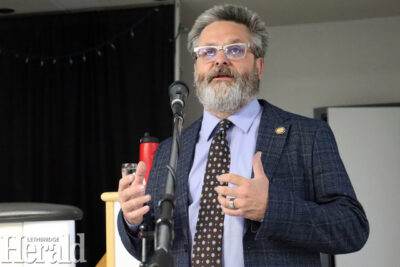SACPA talk focuses on medical training school
By Al Beeber - Lethbridge Herald on May 24, 2024.
 Herald photo by Al Beeber -
Jon Doan, Dean of the Faculty of Health Sciences, speaks to SACPA Thursday about the new rural medical training centre being established at the University of Lethbridge.
Herald photo by Al Beeber -
Jon Doan, Dean of the Faculty of Health Sciences, speaks to SACPA Thursday about the new rural medical training centre being established at the University of Lethbridge.LETHBRIDGE HERALDabeeber@lethbridgeherald.com
A rural medical education training centre at the University of Lethbridge will benefit Lethbridge, southern Alberta and the university itself.
That was one of the messages made at Thursday’s session of the Southern Alberta Council on Public Affairs at the Lethbridge Senior Citizens Organization.
Jon Doan, Dean of the Faculty of Health Sciences at the University of Lethbridge, gave SACPA guests an in-depth look at the genesis of the centre and the progress of its development to this date.
A formal Memorandum of Understanding was signed a week ago today at the U of L by U of L by Provost and Vice-President (Academic) Michelle Helstein and University of Calgary interim Provost and Vice-President (Academic) Penny Werthner.
The two universities are partnering on the centre here which will have $43.2 million of capital funding invested in it by the provincial government.
Two ministries – Health and Advanced Education – are jointly responsible for the centre here and another one to be developed in Grande Prairie to train and hopefully retain doctors for rural communities in the province.
Doan came to the U of L in 2001 and earned his PhD in Behavioural Neuorscience in 2006. He started a faculty position in the Department of Kinesiology and has stayed in the city.
Benefits of the training centre which will begin teaching students in 2025 include improved healthcare access and quality in this city and southern Alberta, educational opportunities of U of L undergraduates, cultural and intellectual enrichment, increasing clinical trials-type of research for faculty and students, public health initiatives and programming, international influence and student/faculty recruitment and innovation and technology transfer.
Other benefits include economic impacts, community outreach and engagement, innovation and technology transfer and interdisciplinary collaborations and research opportunities.
The centre, said Doan, is an opportunity “to train regionally and stay regionally” and an opportunity to recruit regionally, as well.
“Are there ways, are there parts you can bring to the program that really will attract and enable students from the area to become trainees in the area and then to stay as professionals in the area?” Doan asked.
Doan is part of the Southern Alberta Medical Program Working Group which has been working on developing the centre. SAMP has voting members including three each from the U of L and U of C. The group also has representatives from Alberta Health Services, the local and regional medical community, the communities of Lethbridge, Medicine Hat and Pincher Creek and Indigenous community members.
It also has members including post-secondary administrators of the U of L and U of C as well as additional clinicians from southern Alberta.
Doan said recommendations from a consultant include within the accreditation parameters to develop “a distinct and innovative rural medication education program that really brings in that rural learning and living experience.”
Doan said he and other colleagues had a chance to train regionally and stay regional but a student colleague who has now moved onto the University of Alberta to continue studies couldn’t do that.
The rural medical training centre is intended to change that situation.
He said when the U of L was first developed in the 1960s the intention was to deliver local education with some people thinking at the time the U of L would have medical and law schools as well as engineering on campus, basically a shrunken U of A.
The training centre matches well with the challenges being faced in Alberta health care, he said.
Doan told the audience that 140 doctors left Alberta in 2022 and 24 of those left Lethbridge that year. And in 2023, there were initially 21 unfilled family medicine residencies at the U of C.
The government estimates as many as 3,000 family physicians will be needed to meet current needs plus projected growth in the near future, he added.
“And we know that the critical shortage for these family physicians is in rural centres,” he said.
In late 2022, the then Minister of Advanced Education in a mandate letter from premier Danielle Smith was told to work with Alberta’s established medical schools at the U of C and U of A to examine ways to increase the number of physicians in Alberta, particularly in rural areas by partnering with regional post-secondary educations such as the U of L and Northwestern Polytechnic in Grand Prairie, he said.
“We took this information inside the mandate letter as our queue to increase our efforts in this area,” said Doan.
So researching was quickly furthered on distributing medical education using the satellite campus model where an accredited medical school would set up and work with a remote campus to deliver education at that location.
“There is a wide range of research on this topic and it is really centred in Canada and Australia which gives us a great foundation to work from,” Doan added.
27-26




